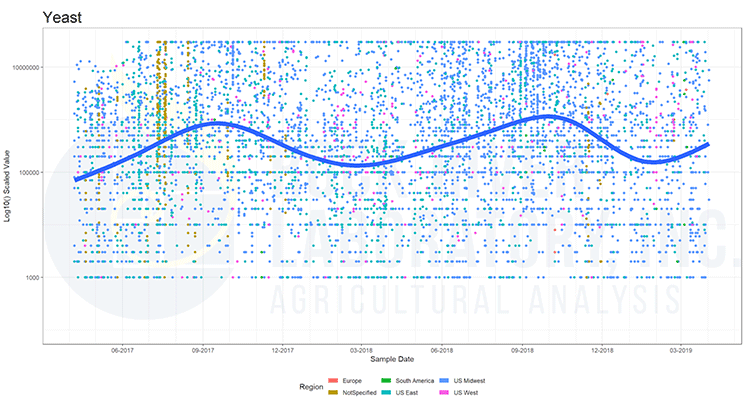
Although the 2019 growing and forage season is here, or almost here in many areas of the country, dairy feeding teams are still being hampered by the 2018 corn silage and grain crop. Rumen and total tract starch digestibility – assessed via dairy or beef fecal starch sampling – continue to showcase opportunities for many farms.
The new goal with dairy fecal starch is less than 1 percent of dry matter (DM). Feed hygiene issues, stemming from last fall’s heavy wild yeast loads in silage following torrential rains, are starting to come back to life as the Upper Midwest and Northeast thaw out (Figure 1). These topics warrant discussion with your nutrition, agronomy, and veterinary advisers.

Looking ahead to spring and summer
Knowing the difficulties of 2018’s crop, it’s time to turn our attention to this spring’s crop, and now is the time to step up your crop scouting efforts. It’s time to scout alfalfa and make stand counts to assess crop health after a tough winter in many regions. In the 2018 Hay & Forage Grower article, “Working through winterkill”, we reviewed a number of good benchmarks to consider with stand counts. Notably, a 10-stem per square foot difference (so 45 stems versus 55 stems) equated to roughly 1 ton of dry hay equivalent per year. Use these benchmarks in economic evaluations and consider replacing stands where stem counts are less than 40 stems per square foot.
Meanwhile, corn is in the ground or well along in Southern regions, and planters are being prepped in Northern regions. One of the hottest topics the past 10 years continues to be the brown midrib (BMR) seed corn debate. I’ve fielded the question countless times, “Is BMR worth it?”
Well, there’s now a suitable tool available for your advisory team to sit around a table and crunch some numbers to determine if it pencils for your farm. A collaborative effort between the University of Wisconsin’s Randy Shaver, Joe Lauer, Bruce Jones, and myself resulted in a decision support tool, which has now been released via Lauer’s website. The spreadsheet partial budget and cash flow projection tool is available for download at: http://corn.agronomy.wisc.edu/Season/DSS.aspx
The purpose of the spreadsheet is to centralize all of the inputs and parameters that need to be considered for an appropriate cash flow projection of various seed selections. The tool is seeded with intake and production data from the University of Florida’s Luiz Ferraretto and Shaver’s meta-analysis published in the Journal of Dairy Science for a starting example, but it is not meant to be an endorsement of any seed genetics or management style.
In my experience during the past few weeks working with the tool and several great nutrition and agronomy consultants through a number of different scenarios, the results swing from the red to the black or vice versa quickly at around $15 per hundredweight milk. Every farm is different, thus bring your nutritionist, agronomist, seed adviser(s), and key farm stakeholders to work through the worksheet together.
To comment, email your remarks to intel@hoards.com.








